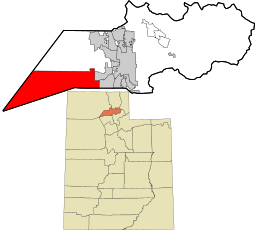Hooper, Utah
| Hooper, Utah | |
|---|---|
| City | |
 Location in Weber County and the state of Utah |
|
| Coordinates: 41°10′2″N 112°7′4″W / 41.16722°N 112.11778°WCoordinates: 41°10′2″N 112°7′4″W / 41.16722°N 112.11778°W | |
| Country | United States |
| State | Utah |
| County | Weber |
| Incorporated | November 30, 2000 |
| Founded by | William Henry Hooper |
| Area | |
| • Total | 11.7 sq mi (30.3 km2) |
| • Land | 11.5 sq mi (29.9 km2) |
| • Water | 0.2 sq mi (0.4 km2) |
| Elevation | 4,242 ft (1,293 m) |
| Population (2012) | |
| • Total | 7,722 |
| • Density | 340.2/sq mi (131.4/km2) |
| Time zone | MST (UTC-7) |
| • Summer (DST) | MDT (UTC-6) |
| ZIP code | 84315 |
| Area code(s) | 385, 801 |
| FIPS code | 49-36400 |
| GNIS feature ID | 1428807 |
Hooper /ˈhʊpər/ is a city in Weber County, Utah, United States, first called Muskrat Springs and later Hooperville for Captain William H. Hooper, an early Utah delegate to Congress. The population was 7,218 at the 2010 census, up from the 2000 figure of 3,926. Prior to the city's incorporation on November 30, 2000, Hooper was an unincorporated census-designated place (CDP).
Hooper is part of the Ogden–Clearfield, Utah Metropolitan Statistical Area.
According to the United States Census Bureau, the CDP has a total area of 11.7 square miles (30.3 km²), of which, 11.5 square miles (29.9 km²) of it is land and 0.2 square miles (0.4 km²) of it (1.45%) is water.
Fremont Island in the Great Salt Lake is included in this city's boundary. On March 30, 2007, Glenn Barrow became the first Hooper mayor to visit the island in the city's brief history.
The current mayor of Hooper is Mayor Korry Green.
As of the census of 2000, there were 3,926 people, 1,150 households, and 1,013 families residing in the CDP. The population density was 340.2 people per square mile (131.4/km²). There were 1,177 housing units at an average density of 102.0 per square mile (39.4/km²). The racial makeup of the CDP was 97.71% White, 0.15% African American, 0.28% Native American, 0.51% Asian, 0.10% Pacific Islander, 0.64% from other races, and 0.61% from two or more races. Hispanic or Latino of any race were 2.06% of the population.
...
Wikipedia
